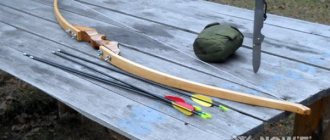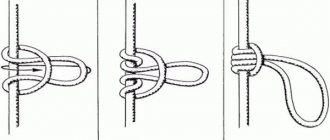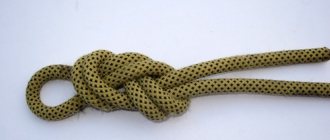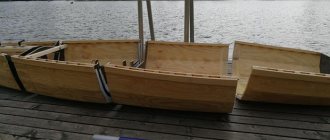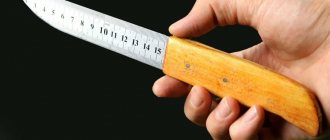Among adults and children who are interested in active hobbies, patterns on how to make a paper boomerang with your own hands are popular. The first mention of this weapon is found in Australia and dates back 50,000 years ago. The oldest artifact from a mammoth tusk was found in the territory of modern Poland, in the Carpathian Mountains - its age is 30,000 years. Since its creation, the weapon has spread widely throughout the world, become an integral part of the culture of many peoples, and has survived to this day in hundreds of different variations. They were actively used to protect the territory and hunt birds. A skillfully thrown weapon could kill a large bird and cause serious injuries to the enemy. Nowadays, they are divided into three groups: sports, collectibles and children's (entertainment). The latest variation will diversify a child’s leisure time, develop spatial thinking and teach accuracy. On the shelves of children's stores there are dozens of models of different colors and shapes for active pastime. However, you can truly diversify your leisure time by creating a paper boomerang with your own hands. Most of the existing assembly algorithms are simple and understandable, so the model can be completed the first time. You can also have fun by assembling a paper boomerang airplane, similar in manufacturing technique. A wide selection of patterns will allow even a child to successfully assemble the product.
In this article we will look at how to make a boomerang out of paper that comes back. We will also tell you in more detail about the history of its origin and the main varieties.
How to make a boomerang out of paper
Figure 1. Australian Aborigines in full armor
The history of the appearance of tools goes back to the Paleolithic era. Ancient people threw fallen and dried branches from trees to shoot down birds or conduct close combat. The main distribution area of this technology: Africa (including modern Morocco and Egypt), Ancient Babylon, India, Southwest America, Oceania, Scandinavia, Germany, the British Isles, Melanesia, Greece and Rome, Australia. They were extremely popular among the Australian Aborigines, as a result of which they became integral elements of the country’s culture (Figure 1). This popularity was due to the fact that bows and other types of weapons did not come into use among Australians due to the impossibility of using them in tropical bushes. Over time, from an ordinary stick, weapons became similar to modern analogues, and their production was carried out by real craftsmen. Before moving on to the diagram of how to make a boomerang out of paper that returns, you should become more familiar with the design features of this unusual weapon.
There are two main subspecies:
- Returning. Returning the weapon to the hands after a successful throw made life much easier for the aborigines. The variety was first used for rituals. Then it found its use in games or training to a greater extent than its non-returning counterparts. The distance between the edges for returning models is up to 46 centimeters, the angle can be either acute or obtuse (from 70 to 110 degrees). It is light in weight, accurately hits the target and has smaller dimensions than its combat counterparts. Capable of flying 90 meters in length and 15 in height before returning to the owner's hands after proper launch. Unlike their combat counterparts, they are propelled by a vertical launch;
- Not returning.
Figure 2. Straight-flying (left) and deviating (right) boomerangs.
In turn, “non-returning” boomerangs are divided into two groups (Figure 2):
- Straight-flying. A larger percentage of ancient items belong to this type. Their early predecessors were the wooden curved clubs "wonna" and the flat primitive swords "bagorro". The length and weight of straight-flying guns are impressive - up to 90 centimeters and 1 kilogram. The inside is often honed to a cutting edge. They were used to hunt kangaroos and emus, as well as during fights. The sharp edge can cut through skin and even cut off heads when thrown correctly. The throw is carried out in a horizontal position, the trajectory is straight. More complex techniques involve throwing it into the ground at a distance of up to 25 meters from the target, after which the weapon is pushed off the surface and crashes into the target. Also among the upright flying ones are the asymmetrical “vatilikri”, which have the shape of a hook or beak at the end of a club. It is considered more of a military technology than a hunting technology, as it was used to overcome a shield, bounce off it and hit an opponent. Hitting birds was also effective, as it was possible to knock down several at a time with a precise hit;
- Deviant. They have a clear aerodynamic profile of two blades. The lower one is flat and pointed in comparison with the upper one. When thrown, they depend on the air flow. The number of edges and curves may vary, and some variations added sharp teeth or ends to the design, making it even easier to hit prey. The throw is carried out horizontally at a slight angle and gives the weapon rotation along the vertical axis. If the throw was carried out technically correctly, the weapon is capable of flying more than several hundred meters before hitting the target.
Next we will give a diagram of how to make a paper boomerang that returns. It can be used for entertainment and sports purposes.
The principle of a paper boomerang that returns
Before you learn how to make a paper boomerang with your own hands, you need to familiarize yourself with the conditions due to which the product is set in motion. The gun is always launched in a vertical plane. A horizontal throw will also help achieve the goal, but the product will not return.
Figure 3. Flight pattern of a paper boomerang
After a vertical impact, the following actions occur:
- The gun tilts to the left under the air currents, instantly tilting to the right. In this way, the straightness of the position is maintained (Figure 3);
- Then it tilts to the right side, after which the axis shifts and a sharp left-hand upward rotation occurs;
- This is followed by a descent, and the gun continues to move to the left until it reaches the initial throw point. If you don’t catch it in time, the projectile flies further, making a circle of smaller diameter and so on ad infinitum until it falls to the ground.
Why is this movement happening?
From a physics point of view:
- While moving horizontally, the air flow hits the blades at a slight angle. This produces a force (also called lift) perpendicular to the blades;
- During rotation, the force shifts to the right and tends to turn the axis of rotation in the opposite direction - to the left. Ultimately, the leading edge rises under the influence of the gyroscopic effect, and the product returns back along the same trajectory that it was launched, but with deviations due to factors such as wind or asymmetrical wings.
Figure 4. Options for an origami boomerang
An origami boomerang works from paper (Figure 4), the diagram of which is identical to a wooden one, according to the same principles as the most ancient analogues.
The physical laws for any throwing returning weapon are the same: paper, plastic, and wood.
Weaving
There are a huge variety of ways to learn how to make paper crafts using the weaving technique. This is a very original approach to creating an exclusive piece.
The simplest technique in this technique is weaving strips in a checkerboard pattern. For those who are not looking for easy ways, working with paper tubes is suitable.
It is worth considering that the properties of the product will depend on the type of material you choose. You can work with:
- plain paper;
- newspaper;
- tape for cash registers;
- glossy magazines.
Please note: it is not recommended to combine different types of material during weaving. However, it is much easier to work with durable raw materials.
This way you will get a durable and high-quality product. Once the product is woven, you can decorate it as you wish. There are no restrictions here.
Read here: Craft bouquet - a selection of creative ideas and a description of their implementation with your own hands (90 photos)
What do you need to make a paper boomerang?
A paper boomerang is created with your own hands according to a pre-conceived pattern. For the base, choose a thin (office A4) or thick sheet (cardboard). After you decide which type of canvas is best to choose for creating the blades, you need to move on to manufacturing the parts. A reliable design can be assembled in just a few minutes if you follow clear instructions on how to make a paper boomerang. The number of edges can be more than two. Three- and four-wing models are very popular among outdoor enthusiasts. Their flight path differs from their standard L-shaped counterparts. However, a right angle can be achieved with only two or four wings.
When drawing a diagram of how to make an origami boomerang out of paper, you should take into account that the process of joining the parts is overlapping, which increases the aerodynamic qualities.
When applying elements to a sheet, you can achieve clarity and symmetry using an ordinary stationery ruler.
The tools include (Figure 5):
- The basis. Selected according to the wishes of the creator. You can choose a pre-decorated or colored sheet. When designing crafts with children, it is recommended to use a large number of prints and avoid plain paper;
- Scissors, blade or utility knife. Will be needed to cut out the main components of the structure, if any;
- Measuring ruler. Necessary for determining the exact distance and angles between the blades, which will guarantee the high efficiency of the product;
- Glue, tape or tape. In some cases, the design requires fixation, which can be done perfectly with PVA or electrical tape.
Figure 5. Tools for creating a boomerang
For the little ones
From a very young age, children begin to show interest in paper. We invite parents and their children to make a bright and beautiful bird. Your baby can use it to play or decorate the room.
Before you start working, you should prepare. You will need a bird template, cardboard, thin paper (square) and colored pencils or markers. Using this template you cut out the bird. Then draw the beak, feathers and tail.
Wings are made from a thin square sheet of paper. To do this, you need to fold it like an accordion and then secure it in the body of the bird in a previously prepared hole.
It is important to remember that the cutting process must take place under the strict supervision of an adult. And don’t forget to explain to your child that after work all tools should be put back in their places.
Decorate the bird by gluing ribbons, sparkles or rhinestones on it.
Read here: Crafts from newspaper tubes: 105 photos, step-by-step instructions and tips for beginners
Making a boomerang out of paper
There are many algorithms for making a paper boomerang with your own hands.
The most important thing is not to be afraid to make mistakes and experiment during the creative process. We will consider a variety of assembly techniques for the most popular models below.
The following instructions will show you how to easily make a boomerang out of paper:
- Option one. You can use not only office sheets, but also a box of Hercules cereal or rice cereal. This method is considered the simplest how to make a paper boomerang. Using office canvas, cut out several identical layers and connect them together with glue;
- Place the sheet horizontally and draw on the X and Y axis (vertical and horizontal lines that touch in the middle);
- Maintaining symmetry, draw approximately the wings of the future craft. Check their specularity using a ruler. Also, ideal proportionality can be achieved by making one wing, cutting it out and attaching it to the axis, tracing it two, three or four times;
- Cut out the finished product;
- Bend each wing 25 millimeters on the right side;
- Check how good the aerodynamic properties of the craft are at the exit;
- The throw is carried out parallel to the floor at one end.
Figure 6. Scheme of a paper boomerang
Option two. The origami technique opens up a wide range of possibilities, including how to create a paper boomerang with your own hands. Using ancient Japanese technology is not as difficult as it is made out to be for the untrained user.
The diagram will help you assemble a boomerang from paper (Figure 6):
- Take one sheet of A4, lay it horizontally and cut it in half in this position. One half will be enough to create;
- Bend the piece in half widthwise. Then each half is folded in the middle again. The halves folded in half are wrapped in triangles on the left edge of the craft;
- We unfold the sheet again and leave only one folded side untouched. A diamond appeared in the middle of the unfolded canvas. It needs to be made clearer and all sides directed outward. To do this, turn the craft over to the back side and make all the edges convex by pressing the sheet with your fingers;
- We turn the workpiece into a vertical position so that the diamond is on the left side. The lower half of the rhombus should be pressed to the bottom, after which the part will begin to bend to the left with the letter “G”;
- To strengthen the structure, it is necessary to bring the edges to the central axis. We bend the right wing, thanks to which a clear right angle appears. The inner side of the left wing is folded into a pocket, and the body is considered almost complete;
- The only thing left to do is to ensure the sharpness of the edges of each wing, which will increase the aerodynamic properties. To do this, first bend the edges of each blade, then straighten and bend inward.
When assembling, the main thing is to maintain symmetry and proportions, and not try to make the product “by eye”. However, knowing how to make a paper boomerang is not enough, since you also need to know how to handle it.
